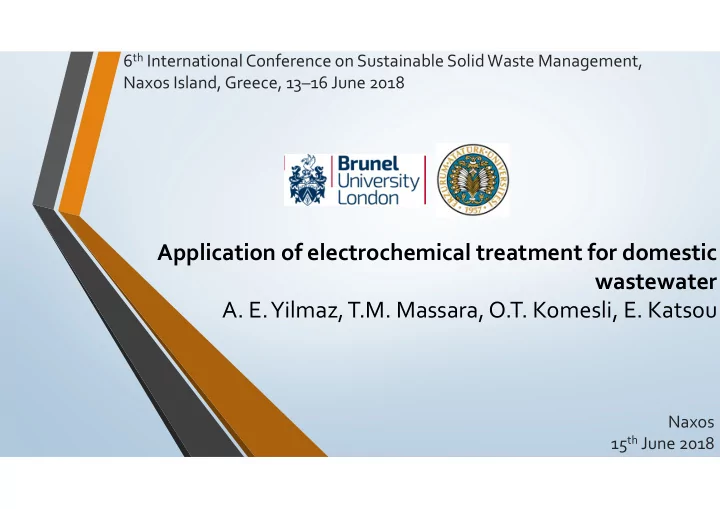

6 th International Conference on Sustainable Solid Waste Management, Naxos Island, Greece, 13–16 June 2018 Application of electrochemical treatment for domestic wastewater A. E. Yilmaz, T.M. Massara, O.T. Komesli, E. Katsou Naxos 15 th June 2018
Contents • Introduction • Objective • Materials & Methods • Results • Discussion 2
Introduction • Limited water resources & inadequately treated wastewater = immense global environmental issues • Mitigate water pollution & promote water reuse = absolutely essential Target Pollutants Causes: Highly variable: industrialization over time in terms of recent technological quantity advances 3 Optimization of water treatment = very important research topic!
Introduction o Electrocoagulation: • in ‐ situ generation of coagulants by electrical dissolution of electrodes • effective pollutant removal (e.g. toxic metals, oil mill wastewater, metalloids, COD, etc.) especially with aluminum/steel electrodes o Optimization of key process parameters: important for maximizing process effectiveness 4
Objective Examine the effectiveness of electrocoagulation for COD removal from domestic wastewater different initial pH values 5
Materials & Methods o Domestic wastewater from the city of Erzurum (Turkey) (COD=250 mg L ‐ 1 , BOD 5 =175 mg L ‐ 1 , SS=80 ‐ 100 mg L ‐ 1 , conductivity=1,000 ‐ 1,050 μ S cm ‐ 1 , temperature=15±3 °C) o Lab ‐ scale, jacketed, rectangular reactor (V=1 L) o 7 stainless ‐ steel electrodes (cathode) & 7 aluminum electrodes (anode) o distance between the electrodes=5 mm; total surface area=2,400 cm 2 Experimental setup: 1: circulator, 2: multimeter, 3: pH o Constant current density=10 A control cell, 4: peristaltic pump, 5: reactor, 6: anode electrode (aluminum), 7: cathode electrode (stainless ‐ o Reaction time=30 min steel), 8: control panel, 9: power supply. 6
Materials & Methods C C 0 e Eq. (1) (%) x 100 C 0 C 0 : initial pollutant concentration (mg L ‐ 1 ); C e : the • Equation 1: calculation of the remaining concentration of the pollutant in the wastewater at time t (mg L ‐ 1 ) treatment efficiency • Equation 2: calculation of the � �� � � � � ∗ � ∗ � Eq. (2) � � � system’s energy consumption W: energy consumption (kW ‐ h m ‐ 3 ), I: applied current (A), V: potential difference in the system (V), t: reaction time (min), ϑ : total wastewater volume (m 3 ) 6
Results Initial pH effect 6.5<pH<8: Aluminum Formation of hydroxide pH>8: aluminium ( Al(OH) 3 )= tetrahydroxyaluminate hydroxides with high amphoteric ‐ ) ion (Al(OH) 4 adsorption capacity coagulant; predominance; flocs (e.g. Al(OH) 2+ , pH ‐ dependent + , Al 2 (OH) 2 4+ , Al(OH) 2 formation 7+ ) Al(OH) 3 , Al 13 (OH) 32 6
Results Initial pH effect Highest COD removal ( ≈ 87%) at the original wastewater pH value (i.e. 7.8) 80 Lowest COD removal ( ≈ 55%) for an COD removal (%) 60 initial wastewater pH=5 40 Different initial pH values (i.e. 5, 6, 7 & 7.8) tested; (current density=10 A; 20 electrocoagulation duration=30 min) pH 5 pH 6 pH 7 Original pH 0 0 10 20 30 o Solid Al(OH) 3 dominant Reaction time (min) o Higher adsorption capacity; enhanced pollutant precipitation 6
Results System Energy Consumption 100 Highest energy consumption (i.e. 95%) at the wastewater original pH (i.e. 7.8) Energy consumption ( kW-h m -3 ) 80 Lowest energy consumption (i.e. 66.5%) at the lowest pH (i.e. 5) 60 Different initial pH values 40 (i.e. 5, 6, 7 & 7.8) tested; (current density=10 A; electrocoagulation duration=30 min) 20 pH 5 pH 6 pH 7 Original pH pH ↓ → electrical conductivity ↑ → 0 0 10 20 30 potential difference applied to the Reaction time (min) system ↓ Eq. 2: potential difference ↓ → energy 6 consumption ↓ if current=constant
Discussion Initial pH effect: • Al(OH)3 dominant aluminium hydroxide; optimal COD high adsorption capacity; pollutant removal at precipitation pH=7.8 Electrocoagulation with initial pH=7.8: • Higher anodic dissolution → higher (i) potential to achieve high release of coagulants COD removal ( ≈ 73%) even at • Longer contact time between very short reaction times (e.g. coagulants & pollutants after only 5 min of operation) (ii) higher COD removal with increased process duration Electrocoagulation • Future work (5 → 30 min) focus: other efficient in domestic parameters wastewater treatment (e.g. current after optimizing key density, etc.) process parameters 6
12
Recommend
More recommend